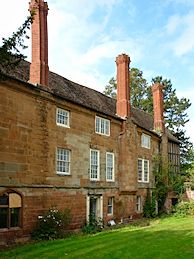|
Index...
|

 s the voices of the Binchois Consort lifted into the high beamed roof of St Mary's Hall, the centuries fell away and we were back in the city's golden age.
s the voices of the Binchois Consort lifted into the high beamed roof of St Mary's Hall, the centuries fell away and we were back in the city's golden age.
In my mind's eye, the modern-day audience of experts in pre-Renaissance music, drawn from all over Europe and the United States, turned into a crowd of richly-gowned merchants and the officials who ran their guilds and their civic administration in fabulously wealthy, fifteenth century Coventry.
Only the music was the same, a Caput, or composition for voices, commissioned by those merchant oligarchs and almost certainly sung in the presence of a king, Henry VI, when he came to honour their town with title of city and county.
It's such an easy thing really, finding our way back into Coventry's illustrious medieval past. And it is extraordinary that we don't do it more often.

People will say that Lady Godiva passes for ancient history in Coventry, that the fable of a saintly streaker braving indignity for the good of the townsfolk is all we need.
But Godiva is a wraith, her naked ride a figment of monkish imagination. The fifteenth century is real, still all around us in Coventry in tapestry, stone and painted window, in parchment manuscript, timber frame and even song sheet. And it's time we let others share this amazing secret.
The Cousins' War, or the Wars of the Roses, as we know it better, has a new currency at the moment, in drama and documentary on screen, and in the written word too.
Why are we not proclaiming Coventry's part in it, both as trigger, through Richard II's aborted trial by combat on Gosford Green in 1397, as command post of the Lancastrian interest and royal government in the 1450s, and finally as first port of call for Henry VII, father of the Tudor dynasty, after his victory at Bosworth Field in 1485?
That whole century of national incident has a distinctly Coventry hue to it. Yet current promotional literature for the city boasts about a place with Bronze Age roots, a frankly bizarre mis-reading of history.
We trot out Godiva, but so little is known about the real woman that we can't get beyond the mythical ride. Why aren't we putting ourselves on the visitor map with events and celebration of the fifteenth century cast of real flesh-and-blood characters who shaped the future of England right here?

There is nowhere else in the country that can better showcase the culture, art and political life of late medieval England.
Don't take my word for it. That judgement comes from television historian Jonathan Foyle, who in his day job as UK Chief Executive of the World Monuments Fund has been helping to preserve just one aspect of that magnificent heritage, the cathedral's astonishing collection of medieval stained glass.
Quite forgotten to tourism, he says, the surviving art and buildings of Coventry reveal the medieval mindset at the heart of the Lancastrian stronghold and tell the story of the formative years of the Wars of the Roses better than anywhere else.
We have the evidence - the city records for the late Middle Ages are fuller than just about anywhere else's.

We have the buildings - not just St Mary's Hall, surely one of Britain's great hidden glories, but our imposing central churches and compelling survivors like the Old Grammar School, Cheylesmore Manor, Whitefriars and the Charterhouse.
There is a groundswell of new ideas emerging, from a virtual tour of medieval Coventry to an event highlighting Henry VII's civic welcome in this city just two days after Bosworth, effectively the first feast of the Tudor Age.
There is work already beginning to make the Charterhouse the focus of an ambitious scheme of landscape and building restoration that will bring a whole string of Coventry's dormant assets back to life.
The time is right, surely, for all of this to be drawn together into a celebration that in future years would build into an annual summer festival able to draw serious visitor numbers to Coventry, making the city more than just an afterthought to Stratford and the castles of Warwick and Kenilworth.

Perhaps the currently disused Whitefriars, another hidden gem, could become the focus for some of this story-telling? For this is all about story, that timeless impulse we all have to make sense of our world.
In Coventry we have a terrific story to tell and as our neighbours in Leicester prepare to celebrate their posthumous connection with Richard III with a new visitor centre in their city next year, the time has come to tell it better.
If we are serious about putting together a City of Culture bid for our city, we shall need nothing less.
Website by Rob Orland © 2002 to 2025